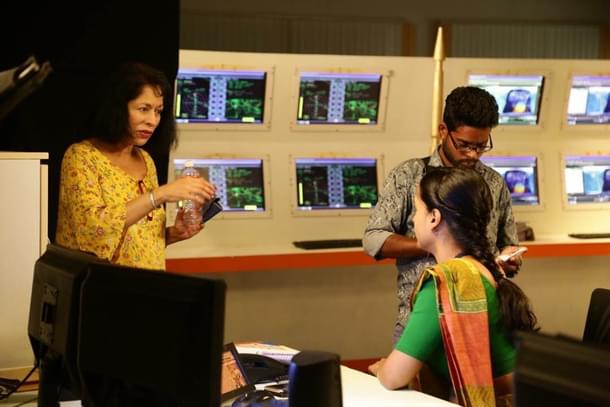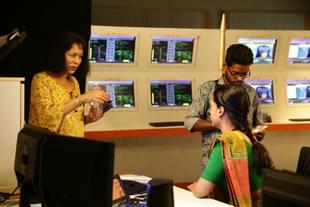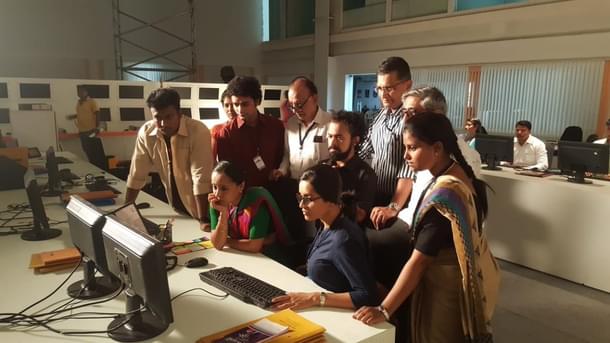Movies
Swarajya Talks To Radha Bharadwaj, The Maker Of Space MOMs — Original Story Of Women Behind India’s Mars Mission
Prakhar Gupta
Jul 09, 2019, 04:35 PM | Updated 04:34 PM IST
Save & read from anywhere!
Bookmark stories for easy access on any device or the Swarajya app.


In September 2014, India successfully put an orbiter around Mars in its first attempt. It was an unparalleled feat — no other country had managed to do so in its first attempt. Soon, a photograph of women celebrating the success of the Mars Orbiter Mission (MOM) in what looked like a control room at the Indian Space Research Organisation went viral, with captions suggesting that these women were scientists.
The description was not accurate and ISRO clarified that they were part of its administrative staff. But the message that it sent was on point — ISRO was not a male reserve, and several women scientists had indeed worked on the MOM project and were present in the control room at the time of the launch, monitoring vital parameters.
US-based filmmaker Radha Bharadwaj had been following the Mangalyaan project. And when it succeeded against formidable odds, she decided to tell the story of these women, the backseat drivers of the mission, through a film.
Bharadwaj registered her screenplay with the US Copyright Office in 2016 and started to look for financiers to get the project going. In the process, the filmmaker shared the screenplay with Mumbai-based producer Atul Kasbekar’s firm Ellipsis Entertainment. This move did not bring results for the project, as Bharadwaj and Ellipsis could not reach an agreement, but it also threatened to derail it.
According to Bharadwaj, Ellipsis Entertainment sent the screenplay to actress Vidya Balan despite agreeing to the condition of not sharing it without her permission. And soon after, she learned from media reports that Akshay Kumar and R Balki were co-producing a movie, Mission Mangal, which too is based on the story of the women engineers and scientists at ISRO, and that Balan was set to star in it.
A trailer of the film, featuring Balan and Kumar, was released yesterday.
Bharadwaj has claimed that Kasbekar negotiated the deal for Balan and believes that Mission Mangal draws from her screenplay for Space MOMs. In November 2018, Bharadwaj moved the Bombay High Court and is now waiting for a hearing.
In a conversation with Swarajya, Bharadwaj talks about her film Space MOMs, the idea behind it, and everything that motivated her to go ahead with the project.
Edited excerpts:
1) When did the idea of making a feature film on the Mars Orbiter Mission occur to you?
I got the idea in 2014. I’d been reading about the Mission quite a while before it became a success on 24 September 2014. The idea to bring this Indian success story to the screen, therefore, came to me in 2014.
For many years, I’d been wanting to tell a story onscreen that would present a different perspective on India: a positive one, for a change. Living in the West, I was growing increasingly dismayed at the near-consistent negative depiction of India in media and entertainment. Popular culture shapes attitudes powerfully — often indelibly. It was of great concern to me that these portrayals of Indian men as barbaric sex maniacs and women as hapless victims was not being countered or challenged; worse, many elements in Indian media and entertainment were gleefully doing what they do best: copying their overseas overlords, and infecting young Indians with a deeply flawed, distorted depiction of us, our history and legacy.
The urge to copy, by the way, is a residue of colonialism. Throughout colonialism, some among us had tried to copy the white master in order to please him. And although colonialism officially ended in 1947, the habit of copying survived in a few sectors of Indian society and that has unfairly given us all a bad reputation.
I, therefore, thought what if I make the Mars Mission story into a film? And what if I focus on the women engineers? That would certainly tell a story of Girl Power and female strength — in India. It would provide a refreshing perspective on what India also is — and give a shot of much-needed self-esteem and pride to Indian youngsters.
I started working on the film project in 2014. I drafted and circulated various pitch documents detailing how the film would be an underdog story of women’s empowerment and patriotic India pride, and how it could be used to inspire women —and men — to not only study science, technology, engineering and mathematics, but to aim high in life.
I circulated these documents in both India and the US in order to find allies to bring this story to screen. I finally got a high-level introduction to ISRO in February 2016, and shortly thereafter, ISRO arranged my extensive interviews with various ISRO engineers and with the former chairman.
2) The Mangalyaan story has many angles. Why did you decide to focus on women scientists and engineers?
There were many possible ways to tell the story of Mangalyaan, and many possible perspectives from which the story could be told. I came up with the idea to tell the story through the perspective of the women engineers.
I chose to focus on the women engineers from the start for a deeply personal reason: I am an Indian woman. When Indian women are depicted as a subjugated, helpless bunch of victims, that depiction insults and offends me, my mum and sisters, and my vast brood of female relatives and friends — none of whom take a back seat in any sphere.
That’s why I wanted to focus on the women engineers. If my mission was to correct the distorted perspective that has been hitherto offered by some abroad and in India, let me fire that shot across the bow from a deeply personal space: my own self and my gender.
3) How did you go about researching the subject?
I obtained interviews with the women and men who worked on the mission. These interviews were in-depth and exhaustive.
As per ISRO’s request, and the request of several engineers I interviewed, the characters in Space MOMs are a blend of some real details and a good measure of my creative powers. But I’ve stayed very true to the spirit of these amazing people as I came to know them very personally through my interviews. Without exception, all are 100 per cent products of our country and culture. Their genius, work ethic, humility, spirit of sacrifice, ability to see the big picture while they slogged away on the smallest details, their ingenuity, tenacity — nothing was borrowed or copied from some overseas culture. They all revealed how rooted they were to our culture and practices (mantras, meditation, etc).
4) Researchers and filmmakers often complain about the red-tape in Indian government agencies. How was your experience working with ISRO? Were you given sufficient access to the women part of MOM?
ISRO is an Indian success story. That is reflected in how they operate: effectively and efficiently. I got their support after a high-profile person loved my vision and got me access to the ISRO chairman’s office in February 2016. I was delighted when my liaison at ISRO wrote to convey their support. He promptly came through, connecting me to the engineers. I was given sufficient access, and have kept the real-life heroines and heroes updated on my journey. They are all role models — they have certainly been beacons of light in challenging times.
5) Why did you choose to not have established actors in the film?
Upon getting to know the engineers, I was struck by how they were at the same time ordinary and extraordinary. They were normal, middle-class working women, many of them moms, who just so happened to be rocket scientists. This became a key part of my vision and pitch for the film. I felt that using established movie stars would undermine my depiction of them as just regular women. I happened to be speaking to one of the real-life engineers, by the way, and she endorsed this creative choice of mine.

Plus, trying to tell this story through a big budget star vehicle would be contrary to the spirit of the story. Mangalyaan is a great story because it is about underdogs succeeding on an impossibly tight budget. The fact that the Hollywood space movie Gravity cost more than the actual space mission Mangalyaan is pretty amazing. It wouldn’t make sense to try to tell this story with a splashy star vehicle whose budget rivalled that of the mission itself.
Mangalyaan is an underdog story, and it’s only fitting to tell it with a team of underdogs.
(Bharadwaj chose not to respond to questions about her copyright infringement lawsuit filed in Mumbai in November 2018.)
Prakhar Gupta is a senior editor at Swarajya. He tweets @prakharkgupta.





